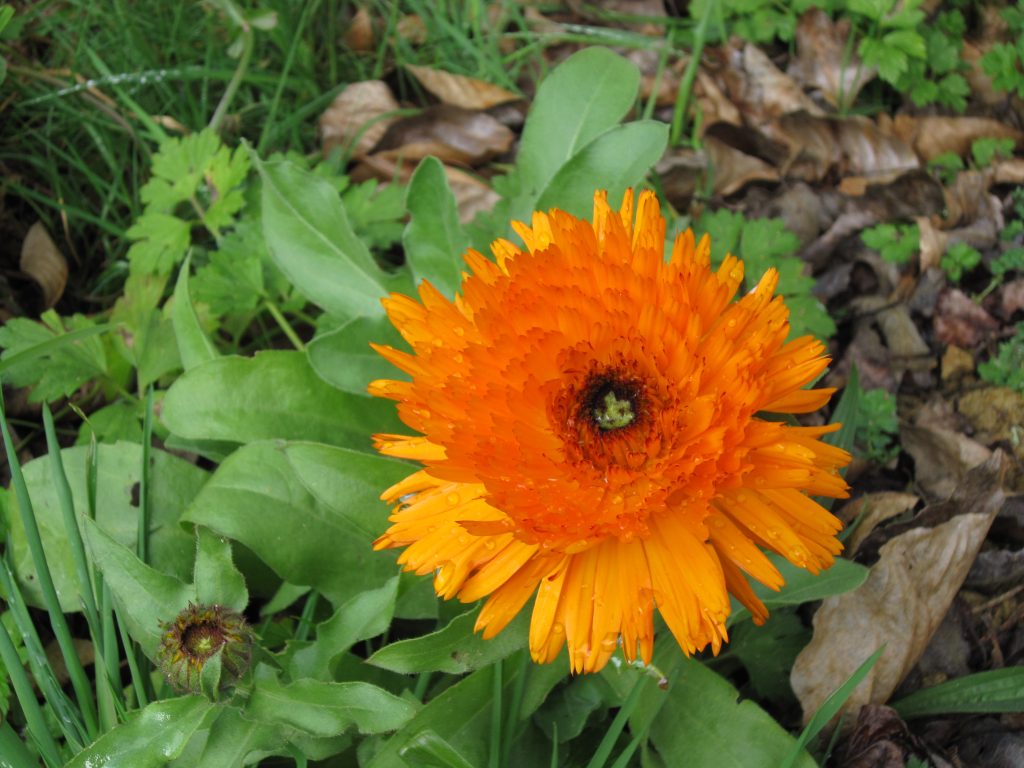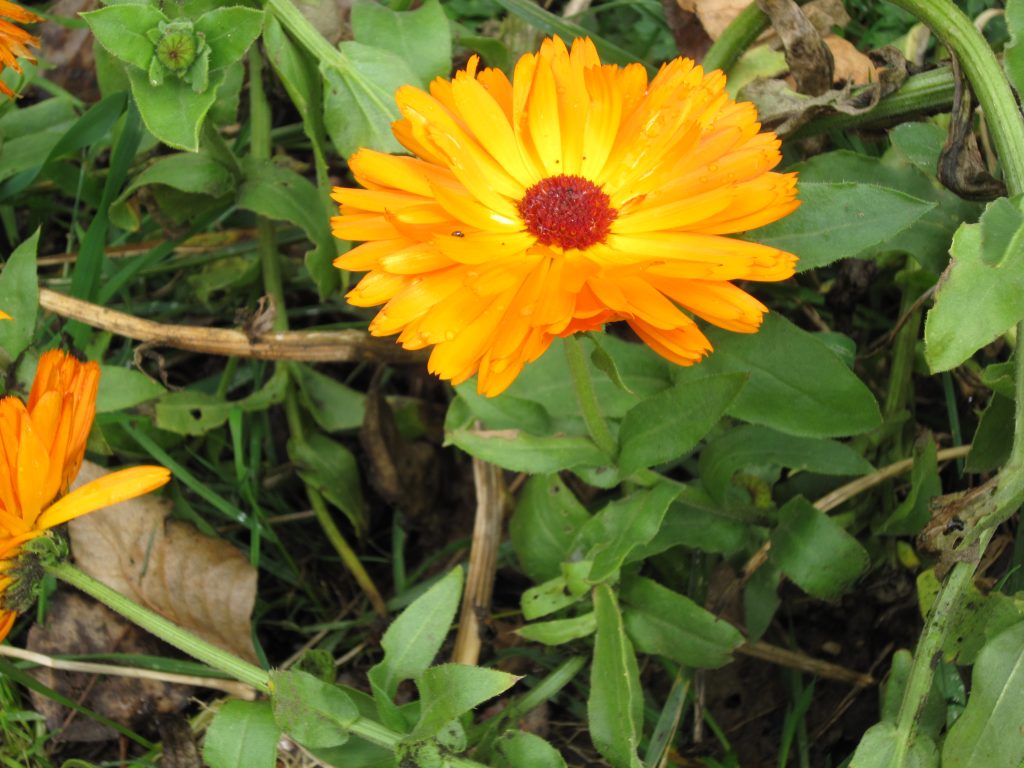Calendula Officinalis is such an easy plant to grow, so common-place, a weed really, like so many of our first aid herbal healers, and yet on further investigation this not-so-ordinary plant holds possibilities for healing on so many levels. In truth, our gardens could be our first port of call if only we wanted to re-educate ourselves just a little and begin to free ourselves from this fear based culture that keeps us dependent on so-called ‘experts’ and encourages us to mistrust all things ‘natural’. Why not start here and now. After you read my blog about this glorious medicine plant go and purchase some seeds or a seedling and plant it in your garden or in a pot for your window-sill. When it’s producing some flowers make calendula tincture and start using it as a wash, for insect bites or stings, sunburn, abrasions, pimples or sores etc. You’ll feel up-lifted and empowered just having the Calendula plant growing around you, knowing each time you see those bright and cheerful blooms that it has shared some of it’s secrets with you. Read the full post for all the details.

Family; Asteraceae or Compositae.
Common names; Marigold, Mary-gold, English Marigold, Mary-bud and Pot Marigold.
Description; small/medium plant growing from 30 to 50cms high. Green, strongly pungent, rough, lanceolate and slightly sticky leaves with bright yellow or bright orange flowers. The flowers are daisy-shaped and can measure between 5-7cms across.
Parts Used; flowers, leaves, stalks.

Preparations; creams, lotions, salves, washes, as essential oil, tinctures/extracts and homeopathic remedies.
Habitat; Cultivated as an annual garden plant which easily naturalises on wastegrounds and roadsides etc. It is thought to have originated from Egypt, spreading throughout the mediterranean region and is now commonly found all through the temperate regions of the world. It tolerates a wide range of soils but thrives in dry soils in full sun. The plant readily self seeds.
Traditional and Historical Uses; Calendula Officinalis has been used in herbal medicine since the early 12th century, and been especially cultivated for this purpose. Traditionally and historically used in the Middle East, Europe, India and USA for wound healing, burns, skin irritations, jaundice, conjunctivitis, stomach ulcers, varicose ulcers, haemorrhoids, gingivitis, pharyngitis and?to induce menstruation to name just some of it’s applications. In the North American Civil War Calendula was used by surgeons to stop bleeding and heal wounds. During World War 1, Gertrude Jeckyll, a well known English gardener “gave an area of her estate for the exclusive cultivation of pot marigolds….the flowers that bloomed there were sent in superb quantities to France for being employed in dressings for the wounded”, recorded in “In an Herb Garden” by Annie Burnham Carter.
Therapeutic Actions; Pharmacological studies have confirmed that Calendula Officinalis exhibits a broad range of biological effects, such as antimicrobial (Attard and Cuschieri, 2009; Radioza and Iurchak, 2007; Roopashree et al., 2008) anti-inflammatory (Amoian et al., 2010; Preethi et al., 2009; Ukiya et al., 2006) immunomodulatory (Attard and Cuschieri, 2009), antioxidant (Etkovi et al., 2004; Fonesca et al., 2010), wound healing (Leach, 2008, Preethi and Kuttan, 2009) antiviral (Kalvatchev, 1997) and anti-tumoral (Ukiya et al., 2006).
Constituents; carotenoids (flavoxanthin, auroxanthin, lutein, zeaxanthin), beta-carotene, polyphenols, flavonoids, triterpenes, saponins, polysaccharides, resins and volatile oils.
Medical Uses; As mentioned above pharmacological studies have confirmed that Calendula officinalis does fantastic healing work. Studies suggest that it relieves inflammation and improves immunity by blocking certain inflammatory compounds and limiting the infiltration of white blood cells (an immune response to inflammation) into tissues. Calendula has also been found to stimulate the growth of new tissues and blood vessels when applied externally to wounds. It can be used with excellent results as an ointment applied to 1st, second and third degree burns to stimulate regrowth of skin and to diminish scar tissue formation.?In the former Soviet Union, there is a long history of cultivation of herbs employed for medicinal use. Calendula was known as Russian penicillin owing it to its extensive cultivation in the USSR for this purpose.
Current Herbal Uses. Externallly; as a skin healer for leg ulcers, sores, abscesses, infected and inflamed skin, acne, impetigo, insect bites, broken skin, wounds, surgical snippings, healthy scar tissue formation, sore nipples in nursing mothers, dry skin, diaper rashes, 1st, 2nd and 3rd degree burns, liver spots, haemorrhoids, varicose veins, fungal infections, as an eyewash for conjunctivitis, a gargle for pharyngitis, after tooth extraction, compresses for aphthous stomatitis and?gingivostomatitis, as a douche for vaginal infections and candida. Internally; for fever, jaundice, hepatitis, cirrhosis, digestive colic, stomach and duodenal ulcers, post operative wound healing, to regulate menstrual flow, as a uterine tonic, enlarged and inflamed lymph glands. Studies suggest that it could be useful for cancerous tumours and HIV. (Assaz N.A.et al.,2008, Waseem S. et al., 2010).
Gardening Applications; Calendula makes a good companion plant amongst herbs and vegetables as it repels tomato hornworms and asparagus beetles. It also attracts caterpillars, leafhoppers, aphids and whiteflies, shield bugs hence it’s use as a catch crop. The flowers also attract beneficial insects like bees.?
Naturally by Trisha products using Calendula; The Warrior Balm, Everyday Balm, Viral Salve, Baby Bottom Balm, Mother’s Bottom Balm, Calm Comfort cream, Teenage Cream.
I sure will 🙂